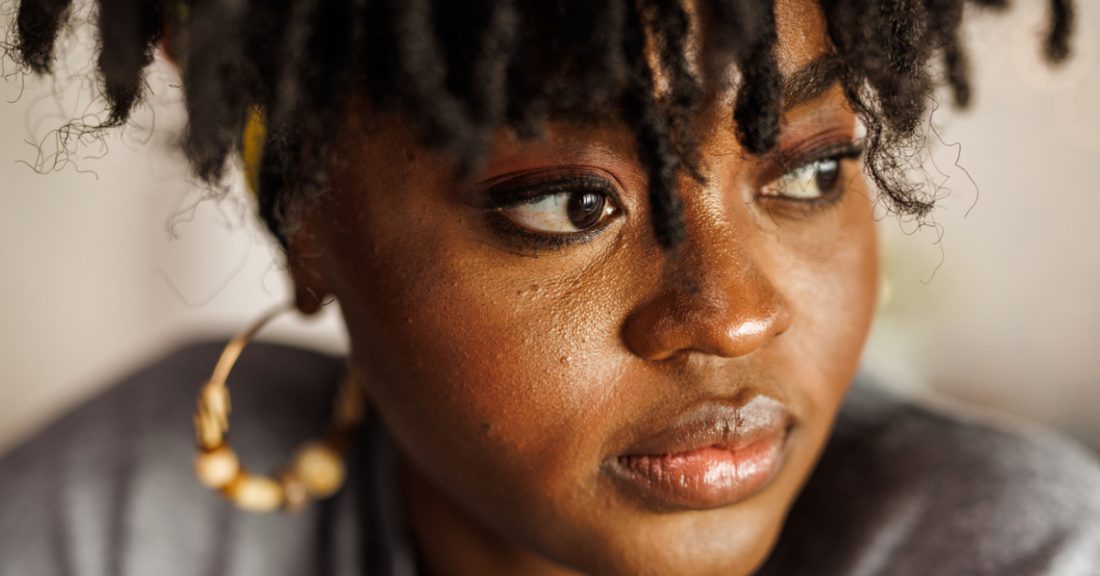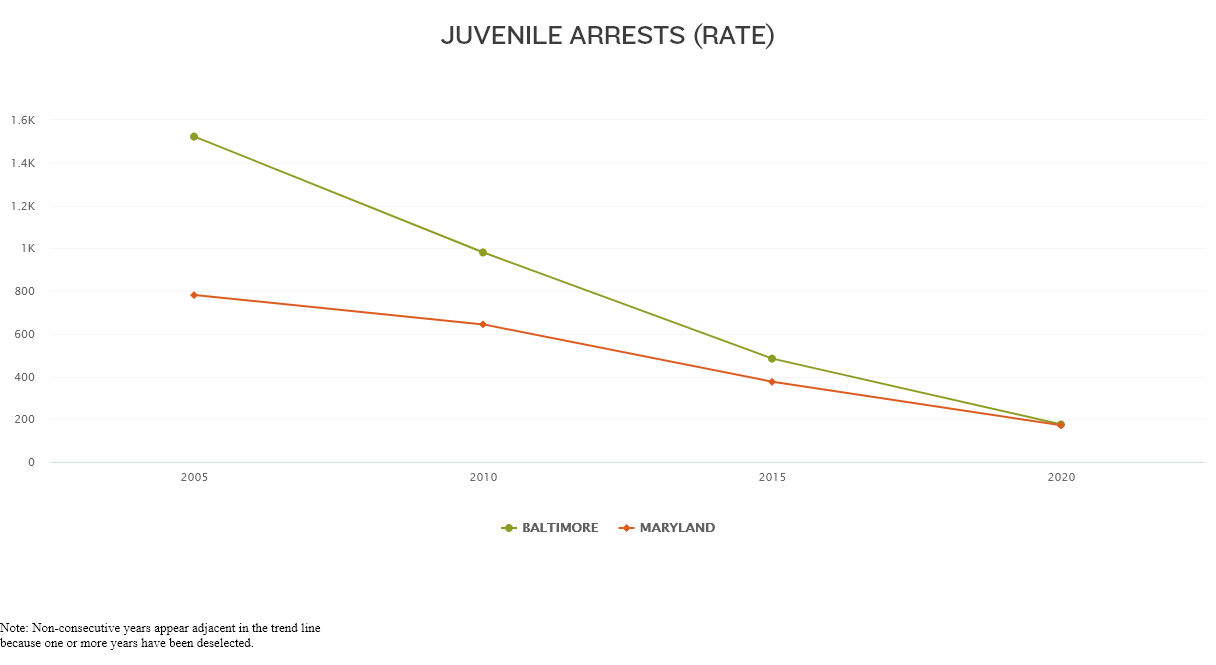A Profile of Youth and Young Adults in Baltimore

The age span from 14 through 24 marks a critical stage of development. During this phase, young people experience profound physiological changes and must navigate increasing autonomy while forming their identity, expanding their socio-emotional and life skills, advancing their education, acquiring job training and more. This period of time is also a window of opportunity for parents, caregivers and caring adults — as well as for programs and policies — to support young people and their future.
Get data and resources delivered to your inbox
The Annie E. Casey Foundation’s KIDS COUNT® Data Center, in collaboration with local partners, provides data on the well-being of youth and young adults in Baltimore. This data is wide-ranging and explores demographics, poverty, education, employment, health, teen births and more.
Key Findings on Baltimore’s Youth
Issues such as poverty, mental health and dating violence remain serious challenges for young people in Baltimore. At the same time, the city has made meaningful improvements in other areas, including reducing juvenile arrests, teen births and tobacco use. Additionally, while Baltimore has achieved long-term progress on youth educational outcomes and the transition to adulthood, the latest data show several indicators taking a turn in the wrong direction, such as high school dropout rates and college enrollment or completion. Below is a selection of some key findings by topic.
Demographics
- Baltimore has 26,094 youth ages 14 to 17. These residents represented 22% of the city’s child population in 2023
Poverty
- Poverty increased among Baltimore’s school-age kids in 2023. The city’s poverty rate for children and youth ages 6 to 17 jumped from 24% in 2022 to 28% in 2023. This rate had previously spiked between 2018 and 2021 — reaching 32% — then fell by 8 percentage points in 2022, before rising again in the latest year. The city’s 2023 rate is nearly three times the statewide rate of 10% and well above the national rate of 16%.
- In 2022, at least 1 in 5 young adults in Baltimore lived in poverty, a decrease from previous years. While young Baltimoreans ages 18 to 24 experienced high poverty rates (about 30% or higher) for much of the past decade, the rate has generally declined since 2014 — from 35% to 21% in 2022, with the exception of a surge in 2021. Similar to figures for children, Baltimore’s young adult poverty rate remains above the Maryland (14% in 2022) and U.S. (19%) rates.
Education
- Baltimore’s high school dropout rate jumped by more than 5 percentage points in 2022. After falling to 12.5% in 2021, the city’s four-year adjusted high school dropout rate rose to 17.8% in 2022, the highest rate since 2010 and more than double the statewide rate. Maryland’s dropout rate also increased from 7.4% in 2021 to 8.5% in 2022. The city’s four-year adjusted graduation rate, on the other hand, has been relatively stable over the last decade but gradually decreased from 72.2% in 2018 to 68.7% in 2022. This statistic is available by racial and ethnic group and illustrates that some students of color consistently face more hurdles to timely graduation, locally and statewide.

- Baltimore saw a small rise in teens ages 16 to 19 who were out of school and without a high school degree in 2022. The city’s share of teens who were both out of school and lacked a high school diploma increased from 2% in 2021 to 5% in 2022, just above the state (3%) and national (4%) averages. Overall, however, Baltimore has made substantial progress on this measure since 2005, when the figure was 13%.
The Transition to Adulthood
- After six years of progress, Baltimore saw an uptick in teens not in school and not working. The share of young people ages 16 to 19 who were not in school (full- or part-time) or employed (full- or part-time) inched up from 7% to 8% between 2021 and 2022, after a large improvement from 15% in 2015. This statistic was sitting well above state and national averages for more than a decade, but Baltimore’s rate is now close to both the national rate of 7% and the state rate of 6%.
- In 2022, nearly 1 in 6 young adults across Baltimore were not in school, not employed and had only a high school diploma degree. This statistic helps to gauge if young people ages 18 to 24 are struggling to transition to adulthood. The share of young adults in this category fell from a high of 25% in 2009 to 14% in 2019 before slightly increasing to and holding at 16% in 2021 and 2022.
- The share of young Baltimoreans who had completed or were enrolled in college decreased by seven percentage points in one year. While the percentage of young residents ages 18 to 24 who fit this statistic substantially increased from 43% in 2006 (first year available) to 58% in 2021, it dropped to 51% in 2022. This rate now falls in between the statewide average of 53% and the national average of 48%.
Safety
- Baltimore’s juvenile arrest rate plunged by nearly 90% from 2005 to 2020. The city’s arrest rate for juveniles ages 10 to 17 fell sharply — from 1,522.3 arrests per 10,000 youth to 175.9 arrests per 10,000 — over the 15-year period where data is available. The city’s 2020 rate, which covers arrests for both violent and nonviolent crimes, was slightly above the 2020 state rate (171.8 arrests per 10,000 youth) after besting the state rate in 2019 for the first time in the years available on the KIDS COUNT Data Center.

- About 1 in 8 Baltimore high schoolers report experiencing physical dating violence. In 2022–2023, 13.3% of high school students citywide reported being physically hurt by someone they were dating. This rate exceeds the statewide rate, which was 11.5% for 2022–23. In 2013, the rates were lower for high school students in both the city (12.8%) and the state (11.1%).
- Across Baltimore, 35 teens ages 15 to 19 died in 2021. While the city’s annual count fluctuates, it has hovered between 22 and 41 deaths per year over the last decade. Although this number increased from 2018 to 2020, it decreased in 2021.
Health
- Tobacco use fell by almost 50% among Baltimore’s high schoolers. In positive trends for the city: The share of high school students who were actively using tobacco products (at least once in the past month) declined from 29% in 2014–2015 to 15% in 2021–2022. During this same period, marijuana use also decreased (23% to 19%), while alcohol use initially increased and then declined (from 19% to 22%, then down to 16%).
- The share of uninsured children and youth in Baltimore grew in 2023. After seeing a slight improvement between 2021 and 2022, the share of uninsured kids reversed course and jumped 1 percentage point to 5% in 2023. Unfortunately, this rate translates to 1,000 more kids lacking health insurance citywide in 2023. For comparison: 5% of kids and youth across both Maryland and the United States were uninsured in 2023.
Mental Health
- Persistent feelings of sadness and hopelessness have surged among Baltimore high schoolers. This statistic rose from 28% in 2013 to nearly 41% in 2022–2023. Students who fit this statistic reported feeling sad or hopeless almost daily for at least two weeks and ceased some of their usual activities as a result. This same statistic jumped 9 percentage points among high schoolers statewide (increasing from 27% in 2013 to 36% in 2022–2023).
- Nearly 1 in 4 high school students across Baltimore seriously considered attempting suicide in the previous year. This statistic increased from 16% in 2013 to nearly 21% in 2022–2023. This rate is higher than the statewide rate of in 17.9% 2022–2023.
Teen Births
- The teen birth count has plummeted across Baltimore over the past decade. In a consistent trend since 2007, the number of births to teenagers ages 15 to 19 has fallen by more than half — from 818 in 2013 to 390 in 2022. See births for younger teens compared to older teens.
- The teen birth rate across Baltimore has also fallen dramatically since the early 2000s. The rate of live births per 1,000 teens ages 15 to 19 has dropped by 64% — starting at 71.1 in 2003 and last reported as 25.4 in 2021. Despite this progress, the citywide rate still sits at nearly two times the statewide rate of 13.4 live births per 1,000 teens.
- The city’s share of teen births to women who were moms rose slightly in recent years. In 2022, 16% of teen births were to young women under age 20 who were already mothers. This rate is up from 14% in 2020 but remains well below the city’s first figure available, which was 34% in 1990. The latest city rate is now just above the state and national averages — both 14% in 2022.
More Data and Resources on Baltimore Youth and Young Adults
Go to the KIDS COUNT Data Center for more data on how youth and young adults are faring in Baltimore, Maryland and nationally. Learn more about the challenges youth face, as well as opportunities to support them, in the Annie E. Casey Foundation’s Thrive by 25® announcement.
Baltimore’s Promise Launches Expanded Career Pathways Program (Blog)
Youth Works Creates Leadership Opportunities for Young Workers in Baltimore (Blog)
How Baltimore Is Helping Students Transition From High School (Blog)
How Young Adults View Social Connectedness and Access Resources (Report)
The Benefits of Workforce Exposure and Career Programming for Youth and Young Adults (Blog)






